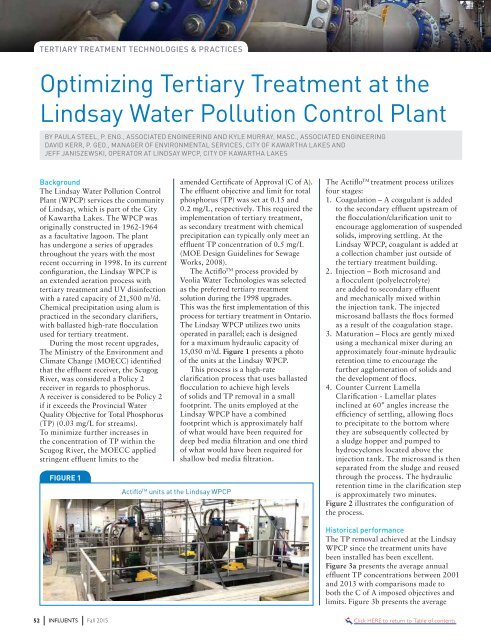lauren@kelman.ca
1YLWYxL
1YLWYxL
You also want an ePaper? Increase the reach of your titles
YUMPU automatically turns print PDFs into web optimized ePapers that Google loves.
TERTIARY TREATMENT TECHNOLOGIES & PRACTICES<br />
Optimizing Tertiary Treatment at the<br />
Lindsay Water Pollution Control Plant<br />
BY PAULA STEEL, P. ENG., ASSOCIATED ENGINEERING AND KYLE MURRAY, MASC., ASSOCIATED ENGINEERING<br />
DAVID KERR, P. GEO., MANAGER OF ENVIRONMENTAL SERVICES, CITY OF KAWARTHA LAKES AND<br />
JEFF JANISZEWSKI, OPERATOR AT LINDSAY WPCP, CITY OF KAWARTHA LAKES<br />
Background<br />
The Lindsay Water Pollution Control<br />
Plant (WPCP) services the community<br />
of Lindsay, which is part of the City<br />
of Kawartha Lakes. The WPCP was<br />
originally constructed in 1962-1964<br />
as a facultative lagoon. The plant<br />
has undergone a series of upgrades<br />
throughout the years with the most<br />
recent occurring in 1998. In its current<br />
configuration, the Lindsay WPCP is<br />
an extended aeration process with<br />
tertiary treatment and UV disinfection<br />
with a rated <strong>ca</strong>pacity of 21,500 m 3 /d.<br />
Chemi<strong>ca</strong>l precipitation using alum is<br />
practiced in the secondary clarifiers,<br />
with ballasted high-rate flocculation<br />
used for tertiary treatment.<br />
During the most recent upgrades,<br />
The Ministry of the Environment and<br />
Climate Change (MOECC) identified<br />
that the effluent receiver, the Scugog<br />
River, was considered a Policy 2<br />
receiver in regards to phosphorus.<br />
A receiver is considered to be Policy 2<br />
if it exceeds the Provincial Water<br />
Quality Objective for Total Phosphorus<br />
(TP) (0.03 mg/L for streams).<br />
To minimize further increases in<br />
the concentration of TP within the<br />
Scugog River, the MOECC applied<br />
stringent effluent limits to the<br />
FIGURE 1<br />
Actiflo TM units at the Lindsay WPCP<br />
amended Certifi<strong>ca</strong>te of Approval (C of A).<br />
The effluent objective and limit for total<br />
phosphorus (TP) was set at 0.15 and<br />
0.2 mg/L, respectively. This required the<br />
implementation of tertiary treatment,<br />
as secondary treatment with chemi<strong>ca</strong>l<br />
precipitation <strong>ca</strong>n typi<strong>ca</strong>lly only meet an<br />
effluent TP concentration of 0.5 mg/L<br />
(MOE Design Guidelines for Sewage<br />
Works, 2008).<br />
The Actiflo TM process provided by<br />
Veolia Water Technologies was selected<br />
as the preferred tertiary treatment<br />
solution during the 1998 upgrades.<br />
This was the first implementation of this<br />
process for tertiary treatment in Ontario.<br />
The Lindsay WPCP utilizes two units<br />
operated in parallel; each is designed<br />
for a maximum hydraulic <strong>ca</strong>pacity of<br />
15,050 m 3 /d. Figure 1 presents a photo<br />
of the units at the Lindsay WPCP.<br />
This process is a high-rate<br />
clarifi<strong>ca</strong>tion process that uses ballasted<br />
flocculation to achieve high levels<br />
of solids and TP removal in a small<br />
footprint. The units employed at the<br />
Lindsay WPCP have a combined<br />
footprint which is approximately half<br />
of what would have been required for<br />
deep bed media filtration and one third<br />
of what would have been required for<br />
shallow bed media filtration.<br />
The Actiflo TM treatment process utilizes<br />
four stages:<br />
1. Coagulation – A coagulant is added<br />
to the secondary effluent upstream of<br />
the flocculation/clarifi<strong>ca</strong>tion unit to<br />
encourage agglomeration of suspended<br />
solids, improving settling. At the<br />
Lindsay WPCP, coagulant is added at<br />
a collection chamber just outside of<br />
the tertiary treatment building.<br />
2. Injection – Both microsand and<br />
a flocculent (polyelectrolyte)<br />
are added to secondary effluent<br />
and mechani<strong>ca</strong>lly mixed within<br />
the injection tank. The injected<br />
microsand ballasts the flocs formed<br />
as a result of the coagulation stage.<br />
3. Maturation – Flocs are gently mixed<br />
using a mechani<strong>ca</strong>l mixer during an<br />
approximately four-minute hydraulic<br />
retention time to encourage the<br />
further agglomeration of solids and<br />
the development of flocs.<br />
4. Counter Current Lamella<br />
Clarifi<strong>ca</strong>tion - Lamellar plates<br />
inclined at 60° angles increase the<br />
efficiency of settling, allowing flocs<br />
to precipitate to the bottom where<br />
they are subsequently collected by<br />
a sludge hopper and pumped to<br />
hydrocyclones lo<strong>ca</strong>ted above the<br />
injection tank. The microsand is then<br />
separated from the sludge and reused<br />
through the process. The hydraulic<br />
retention time in the clarifi<strong>ca</strong>tion step<br />
is approximately two minutes.<br />
Figure 2 illustrates the configuration of<br />
the process.<br />
Histori<strong>ca</strong>l performance<br />
The TP removal achieved at the Lindsay<br />
WPCP since the treatment units have<br />
been installed has been excellent.<br />
Figure 3a presents the average annual<br />
effluent TP concentrations between 2001<br />
and 2013 with comparisons made to<br />
both the C of A imposed objectives and<br />
limits. Figure 3b presents the average<br />
52 INFLUENTS Fall 2015<br />
Click HERE to return to Table of contents


